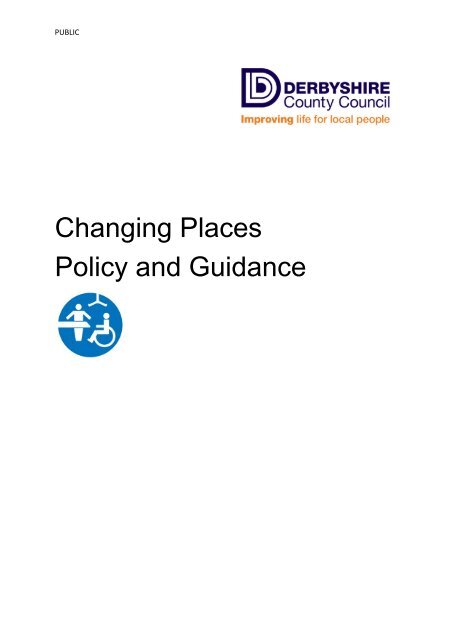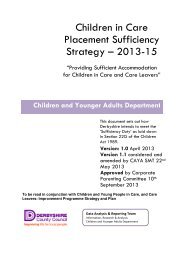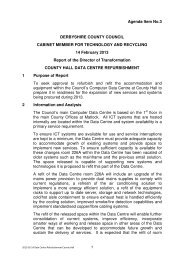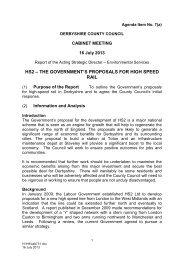Changing Places Policy and Guidance - Derbyshire County Council
Changing Places Policy and Guidance - Derbyshire County Council
Changing Places Policy and Guidance - Derbyshire County Council
You also want an ePaper? Increase the reach of your titles
YUMPU automatically turns print PDFs into web optimized ePapers that Google loves.
PUBLIC<br />
<strong>Changing</strong> <strong>Places</strong><br />
<strong>Policy</strong> <strong>and</strong> <strong>Guidance</strong>
PUBLIC<br />
Version History<br />
Version Date Detail Author<br />
1.0 3/11/11 Completed for<br />
distribution<br />
Louise Machin<br />
2.0 29/8/13 Updated Louise Machin<br />
Contents<br />
Page<br />
Content<br />
3 Introduction<br />
3 Definitions<br />
4 Why are <strong>Changing</strong> <strong>Places</strong> toilets needed?<br />
5 Who is the <strong>Policy</strong> <strong>and</strong> <strong>Guidance</strong> for?<br />
6 <strong>Derbyshire</strong> <strong>Changing</strong> <strong>Places</strong> Working Group<br />
6 <strong>Policy</strong> statement<br />
6 Relevant legislation <strong>and</strong> risk assessment<br />
9 Equipment<br />
10 Management <strong>and</strong> maintenance of facilities<br />
10 Local context<br />
10 References<br />
<strong>Derbyshire</strong> <strong>County</strong> <strong>Council</strong> – <strong>Changing</strong> <strong>Places</strong> <strong>Policy</strong> <strong>and</strong> <strong>Guidance</strong> Page 2
PUBLIC<br />
Introduction<br />
This policy <strong>and</strong> guidance document sets out <strong>Derbyshire</strong> <strong>County</strong><br />
<strong>Council</strong>’s commitment to providing <strong>Changing</strong> <strong>Places</strong> toilets in public<br />
places across <strong>Derbyshire</strong>. We will also work with local partners to drive<br />
the <strong>Changing</strong> <strong>Places</strong> agenda forward <strong>and</strong> encourage others to install<br />
<strong>Changing</strong> <strong>Places</strong> toilets. <strong>Changing</strong> <strong>Places</strong> toilets are necessary to meet<br />
the needs of many disabled children <strong>and</strong> adults, their families,<br />
carers/assistants <strong>and</strong> people with similar needs. The policy reflects the<br />
<strong>Council</strong>’s commitment to equality.<br />
Definitions<br />
<strong>Changing</strong> <strong>Places</strong> Toilet<br />
Sometimes also referred to as a<br />
‘fully accessible toilet’ or ‘hygiene<br />
room’. <strong>Changing</strong> <strong>Places</strong> toilets are<br />
large (preferably 3m x 4m)<br />
accessible toilets allowing plenty of<br />
space for disabled people <strong>and</strong> their<br />
carers/assistants, a peninsular<br />
layout (central) toilet, hoisting<br />
system <strong>and</strong> height adjustable adult<br />
sized changing bench.<br />
A large wash h<strong>and</strong> basin<br />
(preferably height adjustable), wide<br />
tear off paper roll (to cover the<br />
changing bench), large waste<br />
disposal bin, <strong>and</strong> a privacy screen<br />
or curtain are also provided in<br />
addition to the usual sanitary ware<br />
found in accessible toilets.<br />
<strong>Derbyshire</strong> <strong>County</strong> <strong>Council</strong> – <strong>Changing</strong> <strong>Places</strong> <strong>Policy</strong> <strong>and</strong> <strong>Guidance</strong> Page 3
PUBLIC<br />
Accessible toilet<br />
Sometimes also referred to as<br />
‘disabled toilet’ or ‘disabled<br />
person’s toilet’. Accessible toilets<br />
can usually be found alongside<br />
st<strong>and</strong>ard toilet facilities as a unisex<br />
facility.<br />
They are smaller than <strong>Changing</strong><br />
<strong>Places</strong> (usually 1.5m x 2.2m) <strong>and</strong><br />
usually have a corner layout toilet<br />
to allow people to reach the wash<br />
h<strong>and</strong> basin from the toilet. They do<br />
provide minimal room for<br />
assistance but are generally of<br />
more use to independent disabled<br />
people as they do not provide any<br />
specialist equipment.<br />
An accessible toilet should always<br />
be provided in addition to a<br />
<strong>Changing</strong> <strong>Places</strong> toilet.<br />
RADAR lock/key<br />
Often you will find that both <strong>Changing</strong> <strong>Places</strong> <strong>and</strong> accessible toilets are<br />
locked on arrival. This is to prevent misuse <strong>and</strong> damage <strong>and</strong> means that<br />
the facility is more likely to be available when you need it.<br />
RADAR (disability network) has established a National Key Scheme<br />
(NKS) whereby a special lock can be fitted to toilet doors <strong>and</strong> only<br />
opened using a RADAR key. If the toilet is inside a building, a RADAR<br />
key should always be available from staff, but if the toilet st<strong>and</strong>s alone,<br />
you may need your own RADAR key to gain access to the facility. Keys<br />
are available to purchase from RADAR (www.radar.org.uk or Tel. 020<br />
7250 3222).<br />
Why are <strong>Changing</strong> <strong>Places</strong> toilets needed?<br />
Many disabled people <strong>and</strong> people with similar needs, perhaps due to<br />
medical conditions or old age, are unable to use st<strong>and</strong>ard accessible<br />
toilet facilities because they don’t provide enough space or the right<br />
equipment. Some people need support from one or more<br />
<strong>Derbyshire</strong> <strong>County</strong> <strong>Council</strong> – <strong>Changing</strong> <strong>Places</strong> <strong>Policy</strong> <strong>and</strong> <strong>Guidance</strong> Page 4
PUBLIC<br />
carers/assistants when using toilet facilities or having their continence<br />
pads changed.<br />
A st<strong>and</strong>ard accessible toilet does not provide specialist equipment such<br />
as a hoist or changing bench <strong>and</strong> is usually only large enough for one<br />
assistant. The layout of an accessible toilet is better suited to disabled<br />
people who are able to use toilet facilities independently.<br />
Current Building Regulations only require accessible toilets to be<br />
provided, there is no requirement for <strong>Changing</strong> <strong>Places</strong> toilets (although it<br />
is recommended that consideration be given to providing them in certain<br />
situations), <strong>and</strong> as a result of this, <strong>Changing</strong> <strong>Places</strong> are not usually<br />
provided as a matter of course – even in new buildings.<br />
<strong>Derbyshire</strong> <strong>County</strong> <strong>Council</strong> recognises the importance of <strong>Changing</strong><br />
<strong>Places</strong> toilets <strong>and</strong> how valuable they are to many disabled people <strong>and</strong><br />
their families/carers. Without them, carers are often forced to change a<br />
disabled person on a toilet floor (which is dangerous, unhygienic <strong>and</strong><br />
undignified) or else not go out at all.<br />
Who is the <strong>Policy</strong> <strong>and</strong> <strong>Guidance</strong> for?<br />
This policy <strong>and</strong> guidance is for;<br />
• Disabled people, including children, <strong>and</strong> their families <strong>and</strong><br />
carers/assistants<br />
• Other people who require extra space, assistance or equipment to<br />
use toilet facilities e.g. some older people or people with medical<br />
conditions<br />
• <strong>Derbyshire</strong> <strong>County</strong> <strong>Council</strong> Elected Members <strong>and</strong> employees, in<br />
particular;<br />
o Key decision makers<br />
o People who design buildings or co-ordinate major<br />
refurbishment works<br />
o Facilities management teams<br />
o Service departments (Adult Care, Children <strong>and</strong><br />
Younger Adults, Environmental Services <strong>and</strong> Cultural<br />
<strong>and</strong> Community Services)<br />
• Partners <strong>and</strong> other interested parties<br />
<strong>Derbyshire</strong> <strong>County</strong> <strong>Council</strong> – <strong>Changing</strong> <strong>Places</strong> <strong>Policy</strong> <strong>and</strong> <strong>Guidance</strong> Page 5
PUBLIC<br />
<strong>Derbyshire</strong> <strong>Changing</strong> <strong>Places</strong> Working Group<br />
In September 2009, <strong>Derbyshire</strong> <strong>County</strong> <strong>Council</strong> set up a <strong>Changing</strong><br />
<strong>Places</strong> Working group lead by the <strong>Council</strong>’s Learning Disability Service<br />
Manager <strong>and</strong> a local parent/carer. The group has exp<strong>and</strong>ed to include<br />
Officers from across the <strong>Council</strong> who lead on equality issues in their<br />
departments or work with/on behalf of disabled people on a day to day<br />
basis.<br />
The group was set up to continue the good work already completed in<br />
Adult Care <strong>and</strong> by local parent/carers in relation to <strong>Changing</strong> <strong>Places</strong> <strong>and</strong><br />
to drive the agenda forward in <strong>Derbyshire</strong>.<br />
The group meet bi-monthly to work on identifying potential locations for<br />
<strong>Changing</strong> <strong>Places</strong> <strong>and</strong> funding streams, share good practice, raise<br />
awareness <strong>and</strong> encourage others (e.g. local district/borough <strong>Council</strong>s<br />
<strong>and</strong> the private sector) to provide facilities.<br />
<strong>Policy</strong> statement<br />
<strong>Derbyshire</strong> <strong>County</strong> <strong>Council</strong> is committed to making all its public buildings<br />
more accessible for everyone. Every effort will be made to include a<br />
<strong>Changing</strong> <strong>Places</strong> facility in every new building in which the public will<br />
have access to its services. This includes new build Secondary Schools<br />
(but not Infant, Junior or Primary Schools). <strong>Changing</strong> <strong>Places</strong> must be<br />
provided in addition to a st<strong>and</strong>ard accessible toilet, <strong>and</strong> any other<br />
changing facilities required under Part M of the Building Regulations.<br />
The <strong>Council</strong> will also consider including a <strong>Changing</strong> <strong>Places</strong> facility when<br />
it extends or extensively refurbishes an existing public building - these<br />
schemes will be considered on a case by case basis at the early stages<br />
of feasibility/design to establish whether there is an opportunity to install<br />
a <strong>Changing</strong> <strong>Places</strong>.<br />
Relevant legislation <strong>and</strong> risk assessment<br />
Equalities legislation<br />
Equality Act 2010<br />
From April 2011 The Equality Act 2010 places a Public Sector Equality<br />
Duty on public bodies. Under the general duty, <strong>Derbyshire</strong> <strong>County</strong><br />
<strong>Council</strong>, in the exercise of their functions, policies <strong>and</strong> services, must<br />
have due regard to the need to;<br />
<strong>Derbyshire</strong> <strong>County</strong> <strong>Council</strong> – <strong>Changing</strong> <strong>Places</strong> <strong>Policy</strong> <strong>and</strong> <strong>Guidance</strong> Page 6
PUBLIC<br />
• Eliminate unlawful discrimination, harassment <strong>and</strong> victimisation<br />
<strong>and</strong> other conduct prohibited by the Act.<br />
• Advance equality of opportunity between people who share a<br />
protected characteristic <strong>and</strong> those who do not.<br />
• Foster good relations between people who share a protected<br />
characteristic <strong>and</strong> those who do not.<br />
The development of this policy <strong>and</strong> guidance <strong>and</strong> the commitment to<br />
provision of <strong>Changing</strong> <strong>Places</strong> toilets across the <strong>County</strong> will help the<br />
<strong>Council</strong> to meet these three aims of the general duty. In particular,<br />
advancing equality of opportunity for many disabled people, by enabling<br />
them to fully participate in public life.<br />
Health <strong>and</strong> Safety related legislation<br />
Health <strong>and</strong> Safety at Work Act 1974<br />
Under s.2 of the Health <strong>and</strong> Safety at Work Act 1974, all employers have<br />
a duty to “ensure, so far as is reasonably practicable, the health, safety<br />
<strong>and</strong> welfare at work of all his employees”.<br />
This could be relevant, for example, in respect of any staff employed in<br />
buildings where <strong>Changing</strong> <strong>Places</strong> toilets are provided. The employer<br />
would, for instance, have to be clear about the role of members of staff<br />
in facility management <strong>and</strong> maintenance, <strong>and</strong> their competence level,<br />
training <strong>and</strong> supervision, in addition to any policies, <strong>and</strong> procedures.<br />
Under s.3 of the 1974 Act, there is a duty on an employer to “conduct his<br />
undertaking in such a way as to ensure, so far as is reasonably<br />
practicable, that persons not in his employment who may be affected<br />
thereby are not thereby exposed to risk to their health <strong>and</strong> safety”.<br />
This section could apply, for example, to either injury or risk of injury to<br />
users (or their carers) of the toilet. This could arise if a lack of (or<br />
incorrect) information, instructions or warnings were displayed or<br />
provided, or if a hoist was not properly maintained.<br />
Management of Health <strong>and</strong> Safety at Work Regulations 1999<br />
These regulations contain, amongst other things, an explicit obligation to<br />
carry out a risk assessment in relation to both employees (r.2) <strong>and</strong> nonemployees<br />
(r.3).<br />
<strong>Derbyshire</strong> <strong>County</strong> <strong>Council</strong> – <strong>Changing</strong> <strong>Places</strong> <strong>Policy</strong> <strong>and</strong> <strong>Guidance</strong> Page 7
PUBLIC<br />
Lifting Operations <strong>and</strong> Lifting Equipment Regulations 1998, <strong>and</strong><br />
Provision <strong>and</strong> Use of Work Equipment Regulations 1998<br />
If the hoist was used by an employee (i.e. not just simply moved e.g. to a<br />
charging location), the employer would have responsibilities concerning<br />
the examination <strong>and</strong> maintenance of the hoist under these two sets of<br />
regulations.<br />
If the hoist was not used by employees, then these two sets of<br />
regulations would not apply, since they apply only to equipment used at<br />
work. However, s.3 of the 1974 Act <strong>and</strong> r.3 of the Management of Health<br />
<strong>and</strong> Safety at Work Regulations 1999 might then be relevant – in terms<br />
of the duties to non-employees that they contain. In circumstances<br />
where s.3 of the 1974 Act (<strong>and</strong> r.3 of the 1999 regulations) apply, the<br />
Health <strong>and</strong> Safety Executive has stated that it would expect the<br />
st<strong>and</strong>ards associated with the 1998 sets of regulations to be adhered to<br />
in any case. Other equipment that could be operated, e.g. changing<br />
benches or height adjustable wash h<strong>and</strong> basins would also require<br />
maintenance.<br />
Medicines <strong>and</strong> Healthcare products Regulatory Agency (MHRA) advice<br />
<strong>and</strong> <strong>Guidance</strong><br />
The provider would need to ensure that hoist provision, inspection, <strong>and</strong><br />
maintenance arrangements were generally in accordance with relevant<br />
advice issued by the MHRA.<br />
Manual H<strong>and</strong>ling Operations Regulations 1992<br />
Unless a specific attendant was employed, it is unlikely that a situation<br />
would arise where an employee was called on physically to assist a user<br />
of the toilet. A risk assessment under these 1992 regulations, together<br />
with s.2 of the 1974 Act <strong>and</strong> r.2 of the 1999 regulations, might conclude<br />
that the risks posed to such an employee were high <strong>and</strong> unmanageable<br />
<strong>and</strong> therefore they would decline to assist in such a situation anyway.<br />
However, if the person using the toilet is being assisted by a paid carer<br />
they would need to comply with these regulations, so it worth noting this<br />
in the design of a facility e.g. a free-st<strong>and</strong>ing changing bench is likely to<br />
be a better option as it allows carers access to both sides of the user<br />
without having to turn them.<br />
Based on Health <strong>and</strong> Safety Legislation, the <strong>Changing</strong> <strong>Places</strong><br />
Consortium recommends the following;<br />
<strong>Derbyshire</strong> <strong>County</strong> <strong>Council</strong> – <strong>Changing</strong> <strong>Places</strong> <strong>Policy</strong> <strong>and</strong> <strong>Guidance</strong> Page 8
PUBLIC<br />
o Organisations that provide a <strong>Changing</strong> <strong>Places</strong> toilet should carry<br />
out a full risk assessment.<br />
o Organisations that provide a <strong>Changing</strong> <strong>Places</strong> toilet should not<br />
place responsibility on staff to assist people to use <strong>Changing</strong><br />
<strong>Places</strong> toilet facilities.<br />
o An emergency alarm should be fitted in the <strong>Changing</strong> <strong>Places</strong> toilet.<br />
o All specialist equipment, including hoists <strong>and</strong> changing benches,<br />
should be fitted, regularly inspected <strong>and</strong> maintained according to<br />
manufacturer’s instructions.<br />
o The organisation should ensure that the facility is kept as clean<br />
<strong>and</strong> hygienic as possible.<br />
<strong>Changing</strong> <strong>Places</strong> toilets are intended for assisted use, <strong>and</strong> therefore this<br />
should be made clear to people in addition to what their responsibilities<br />
are as a user;<br />
o Instructions that show how to use equipment, <strong>and</strong> any relevant<br />
warnings (including what to do in an emergency), should be clearly<br />
displayed in the facility.<br />
o Organisations should not provide slings.<br />
o Clear information should be provided on the type of hoist provided<br />
in the facility <strong>and</strong> which slings are compatible.<br />
Equipment<br />
The <strong>Derbyshire</strong> <strong>Changing</strong> <strong>Places</strong> Working Group has developed a<br />
performance specification for the equipment required in <strong>Council</strong> owned<br />
<strong>Changing</strong> <strong>Places</strong> toilets (based on the requirements in British St<strong>and</strong>ard<br />
8300:2009) <strong>and</strong> a number of possible layout options based on the<br />
optimum room size of 3m x 4m. The group have also identified suppliers<br />
(although other suppliers can be used if they meet the performance<br />
specification laid out). The group are actively encouraging partners to<br />
use the <strong>Derbyshire</strong> layout <strong>and</strong> specification if they are providing facilities<br />
in <strong>Derbyshire</strong>, the aim of which is to ensure a consistent approach <strong>and</strong><br />
one that has been developed in consultation with carers <strong>and</strong><br />
professionals.<br />
<strong>Derbyshire</strong> <strong>County</strong> <strong>Council</strong> – <strong>Changing</strong> <strong>Places</strong> <strong>Policy</strong> <strong>and</strong> <strong>Guidance</strong> Page 9
PUBLIC<br />
Management <strong>and</strong> maintenance of facilities<br />
How the facility will be managed <strong>and</strong> maintained after installation needs<br />
to be considered at the outset of any proposal to install a <strong>Changing</strong><br />
<strong>Places</strong> toilet. It is likely that costs will be incurred in terms of cleaning<br />
<strong>and</strong> maintenance e.g. of hoist systems, <strong>and</strong> this may have financial<br />
implications if not considered early on. Generally, management <strong>and</strong><br />
maintenance responsibilities will lie with the Facilities Management team<br />
for that establishment, as it does for other equipment <strong>and</strong> cleaning<br />
regimes.<br />
Removal of sanitary waste will need to be programmed in, as will refill of<br />
specialist equipment such as the wide tear off paper roll.<br />
Training should be given to staff in the establishment on how <strong>and</strong> when<br />
to put the hoist in the charging position, how to identify any problems<br />
with the facility <strong>and</strong> who to contact in the event of a problem/fault<br />
reporting procedures.<br />
Staff working in the building in which the <strong>Changing</strong> <strong>Places</strong> is located<br />
should not need to be trained on the actual use of equipment – if people<br />
wish to use the facility <strong>and</strong> the equipment within it but are unsure about<br />
how to use it, they should be advised not to use it at all.<br />
Local context<br />
This <strong>Policy</strong> <strong>and</strong> <strong>Guidance</strong> document does not contain details of local<br />
<strong>Changing</strong> <strong>Places</strong> facilities as the list is being constantly updated as new<br />
facilities become available. The location of <strong>Changing</strong> <strong>Places</strong> in<br />
<strong>Derbyshire</strong> <strong>and</strong> information about the equipment in them can be<br />
obtained from the <strong>Council</strong>’s Access Officer (Tel. 01629 539003). There<br />
is also information available on the <strong>Council</strong>’s website<br />
www.derbyshire.gov.uk<br />
References<br />
Legal framework concerning provision of <strong>Changing</strong> <strong>Places</strong> public toilets<br />
Factsheet (<strong>Changing</strong> <strong>Places</strong> Consortium)<br />
Northamptonshire <strong>County</strong> <strong>Council</strong> – Fully accessible toilets policy <strong>and</strong><br />
guidance<br />
Nottingham City <strong>Council</strong> – Guidelines for the use of <strong>Changing</strong> <strong>Places</strong><br />
toilets<br />
<strong>Derbyshire</strong> <strong>County</strong> <strong>Council</strong> – <strong>Changing</strong> <strong>Places</strong> <strong>Policy</strong> <strong>and</strong> <strong>Guidance</strong> Page 10
















